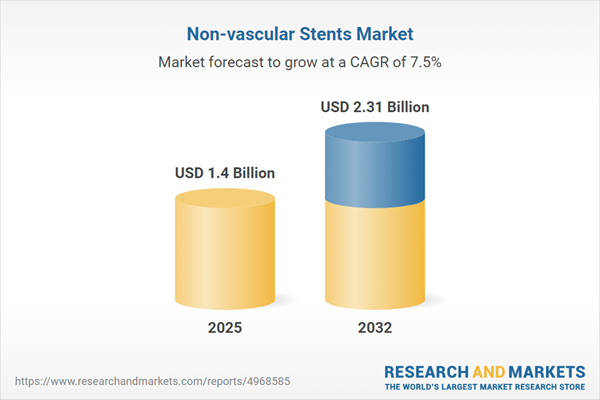Speak directly to the analyst to clarify any post sales queries you may have.
The non-vascular stents market is advancing rapidly, shaped by healthcare priorities favoring minimally invasive procedures and significant technology upgrades. Senior leaders are recalibrating business models and operational frameworks to manage regulatory complexities while maintaining a competitive edge.
Market Snapshot: Non-Vascular Stents Market
Non-vascular stents represent a dynamic market segment supported by strong investment in innovation and growing adoption of minimal intervention solutions. Industry momentum is being driven by providers modernizing their service portfolios with advanced engineered stent systems, which increase both procedural efficiency and patient access to leading-edge treatment options. Evolving materials science and digital production methods are enabling product refinements that closely track regulatory trends and stringent quality requirements. The demand for swift adaptation to industry guidelines and next-generation manufacturing technologies continues to unlock new efficiencies, facilitating sustainable sector growth. The compound annual growth rate (CAGR) and overall market size further highlight robust expansion in this segment.
Scope & Segmentation
- Application Areas: Deployment in airways, including bronchial and tracheal support, underpins respiratory care. Biliary stents are pivotal for enhancing biliary drainage and management. Gastroenterology applications extend support to esophageal and colorectal conditions, while urological stents address diverse needs from ureteric to prostatic and urethral blockage.
- Product Types: Balloon-expandable stents are valued for precise placement in challenging clinical scenarios, while self-expanding designs enable adaptability to tissue variability in individual patients.
- Material Types: Nitinol stents are selected for resilience and flexibility. Bioresorbable polymer options provide temporary support, decreasing long-term procedural risks. Stainless steel is used when extra rigidity or reinforcement is essential for positive outcomes.
- End Users: Hospitals and ambulatory surgical centers utilize non-vascular stents in both routine and complex interventions, increasing procedural capacity and expanding patient services.
- Regional Coverage: The Americas, EMEA, and Asia-Pacific remain at the forefront of technology adoption. Noteworthy acceleration is seen in China, India, Japan, South Korea, and Southeast Asia as investments in clinical infrastructure grow and access improves in emerging economies.
- Featured Companies: Boston Scientific Corporation, Medtronic plc, Abbott Laboratories, Becton Dickinson and Company, Cook Medical LLC, B. Braun Melsungen AG, Merit Medical Systems Inc., Teleflex Incorporated, Endo International plc, and Taewoong Medical Co. Ltd. are leaders shaping market direction and innovation.
Key Takeaways for Senior Decision-Makers
- Robust engineering and enhanced diagnostic imaging have expanded the range and complexity of procedures possible with non-vascular stents, making these devices more adaptable across clinical segments.
- Personalized diagnostic integration with adaptable stent architectures addresses growing procedural complexity and helps optimize patient outcomes.
- Innovations in coating materials and advanced biomaterials back compliance efforts and support reduction in procedural risks across healthcare organizations.
- Regulatory process improvement is enabling healthcare providers to expedite the clinical adoption of new stent devices, smoothing the transition to updated standards of care.
- Efforts to boost supply chain resilience through a focus on local sourcing and nearshoring support consistent delivery, even amid procurement challenges linked to global volatility.
- Collaboration between technology developers and frontline care providers is driving seamless technology onboarding and reducing operational transition hurdles.
Tariff Impact: Adapting to the 2025 U.S. Policy Shift
With recent U.S. tariff changes directly influencing imports of non-vascular stents, there is intensified attention on domestic manufacturing and nearshoring. This emerging trend strengthens supply chain continuity, promotes stable care delivery, and equips procurement teams to navigate cost structure shifts and evolving compliance requirements.
Methodology & Data Sources
This report integrates clinical expertise, procurement insights, current regulatory data, and peer-reviewed research, combined with direct input from senior executive leadership panels to deliver a comprehensive and current analysis of the non-vascular stents market.
Why This Report Matters
- Equips executives with timely insights on innovation and regulatory updates relevant to the non-vascular stents market.
- Supports optimization of supply chains and operational processes, enhancing collaboration and reliability throughout healthcare networks.
- Helps leaders recognize region-specific opportunities and anticipate advances that may disrupt traditional care delivery or procurement strategies.
Conclusion
This analysis provides senior decision-makers with actionable intelligence to support agile strategy and informed adaptation in an evolving non-vascular stents landscape, empowering proactive market engagement and operational resilience.
Additional Product Information:
- Purchase of this report includes 1 year online access with quarterly updates.
- This report can be updated on request. Please contact our Customer Experience team using the Ask a Question widget on our website.
Table of Contents
3. Executive Summary
4. Market Overview
7. Cumulative Impact of Artificial Intelligence 2025
Companies Mentioned
The companies profiled in this Non-vascular Stents market report include:- Boston Scientific Corporation
- Medtronic PLC
- Abbott Laboratories
- Becton, Dickinson and Company
- Cook Medical LLC
- B. Braun Melsungen AG
- Merit Medical Systems, Inc.
- Teleflex Incorporated
- Endo International PLC
- Taewoong Medical Co., Ltd.
Table Information
| Report Attribute | Details |
|---|---|
| No. of Pages | 181 |
| Published | November 2025 |
| Forecast Period | 2025 - 2032 |
| Estimated Market Value ( USD | $ 1.4 Billion |
| Forecasted Market Value ( USD | $ 2.31 Billion |
| Compound Annual Growth Rate | 7.4% |
| Regions Covered | Global |
| No. of Companies Mentioned | 11 |









